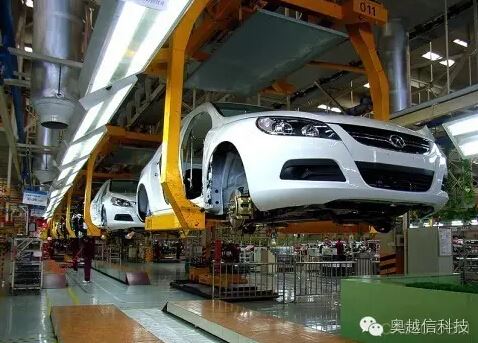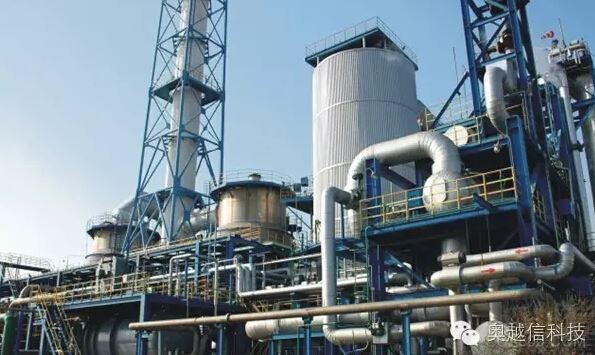
Industrial application of PLC
Metallurgy, as the largest application industry for large-scale PLCs, occupies about one-fourth of the market. The metallurgical industry requires high precision and control points for each control link, and is therefore the main industry for large and medium-sized PLC applications. As far as China is concerned, the status quo of our metallurgical industry is relatively backward and the level of equipment technology is low. We believe that with the improvement of the requirements of the downstream market and the intensification of competition, a large number of technological transformation projects and investments in high-end production lines will be brought about. There are more than 6,000 metallurgical enterprises in China. There are a large number of PLC products in use and many upgrading and spare parts markets.

The automotive industry is one of the most promising PLC industries. It mainly controls the stations of each production line. PLC has a large number of applications, but the number of control points is not high, and it is mostly about 300 I/Os. The medium-sized PLC is the mainstay.
The power industry itself has a high level of automation, and has a large base for the application of PLCs. It is another major industry for large and medium-sized PLC applications. PLC system is widely used in power construction machinery, and has a good market and space.

In the chemical industry, the PLC market has maintained steady growth. In the future, the chemical industry should increase its investment in the fields of synthetic materials and organic chemicals. The demand for automation products in these areas is relatively large. At the same time, due to the improvement of environmental protection requirements in the chemical industry, chemical plants need to renovate the surrounding water treatment and circulation systems, which will create new requirements for automation products.
PLC has been applied in many industries, and domestic companies with strong strengths have begun to expand PLC business and have a certain voice in the Chinese PLC market. For example, OYES domestic brands established in 2008 by Otis Technology Corporation in Shenzhen, PLC- 200 PLC-300 Various types of models, production has been scaled up, market share has steadily increased year by year, and has made a huge response to the market.

PLC's future development trend
Many years ago it was predicted that the PLC would be replaced by the PC-BASED control system. However, sales of PLC are still rising year after year with very stable growth rates. The current PLC has been very different from ten years ago. After ten years, PLC and today's PLC are bound to be different; but there are two aspects are unchanged: First, PLC will provide a stable control response; Second, the height The reliability. The predictable PLC development trends are as follows:
The first is the development of high speed and large capacity.
In order to improve the processing capability of the PLC, the PLC is required to have better response speed and larger storage capacity. At present, the scanning speed of some PLCs can reach 0.1ms/k steps. In terms of storage capacity, some PLCs can be up to tens of megabytes. To expand storage capacity, some companies have used bubble memory or hard disk.
The second is to develop in the direction of super-large and super-small.
At present, there are many small and medium-sized PLCs. In order to adapt to the various needs of the market, PLC will need to develop in the direction of multi-species, especially in the direction of ultra-large and super-small. There are now very large PLCs with I/O points up to 14336 points, 32-bit microprocessors, multiple CPUs working in parallel, and large-capacity memories. The minimum number of configured I/O points is 8 to 16 points to meet the needs of stand-alone and small-scale automatic control.
The third is that PLC will vigorously develop smart modules and strengthen the networking communication capabilities.
PLC manufacturers continue to develop a number of functional modules, such as: Otis's high-speed counting module, temperature control module, remote I / O module, communications and human-machine interface modules. These intelligent I/O modules with CPUs and memories not only extend the PLC functionality, but are also flexible and easy to use, expanding the range of PLC applications.
The fourth is to enhance the detection and processing capabilities of external faults.
According to statistics, in the breakdown of the PLC control system, the CPU accounts for 5%, the I/O interface accounts for 15%, the input device accounts for 45%, the output device accounts for 30%, and the line accounts for 5%. A total of 20% of the first two faults belong to the PLC's internal fault; the remaining 80% of the faults belong to the PLC's external fault. Therefore, PLC manufacturers are committed to developing and developing dedicated intelligent modules for detecting external faults, with a view to further improving system reliability.
The fifth is the diversification of programming languages.
At the same time as the PLC system structure continues to evolve, the PLC programming language has become more and more abundant and its functions have been continuously improved. In addition to the ladder language used by most PLCs, sequential stepping programming language, flow control language for process control, and computer-compatible high-level language have appeared successively. The coexistence, complementarity and development of multiple programming languages ​​is a trend of PLC's progress.
Product Description
SPD Surge Protective Device,Lightning Surge Protector
Surge Protection Device (SPD)
It is a device used to limiting instant surge voltage and discharge surge current, it at least including a non-linear component.
Surge protective Device Model Selection
With the impact of international information flow, the rapid development of microelectronic science and technology, communication, computer and automatic control technology, make the building start to go for high quality, high functional area, formed a new building style-intelligent building. As inside the intelligent building there are lot of information system, <<Building lightning protection design norm>> GB50057-94(2002 vision)(hereafter brief as <<lightning protection norm>>) put forward the relative requirement to install the surge protective device, to ensure the information system safely and stable running.
SPD essentially is a equipotential connection material, its model selection is according to the different lightning protection area, different lightning electromagnetic pulse critical and different equipotential connection position, decide which kind of SPD used in the area, to achieve the equipotential connection with the common earth electrode. Our statement will based on SPD's maximum discharge current Imax, continuous operating voltage Uc, protection voltage Up, alarm mode etc.
As per << Lightning Protection Norm>> item 6.4.4 stipulation "SPD must can withstand the expected lightning current flow and should confirm to the additional two requirements: the maximum clamp voltage during surge across, capable to extinguish the power frequency follow-on current after lightning current across." That is the value of SPD's max. clamp voltage add its induction voltage of two ends should be same with the system's basic insulation level and the equipment allowed max. surge voltage.
SPD for Power Supply System Series Selection Guide
The installation of SPD at each lightning protection zone, according to the standard of low voltage electrical appearance, make classification of electrical equipment in accordance with the over voltage category, its insulation withstand impulse voltage level can determine the selection of SPD. According to the standard of low voltage electrical appearance, make classification of electrical equipment in accordance with the over voltage category as signal level, loading level, distribution and control level, power supply level. Its insulation withstand impulse voltage level are:1500V,2500V,4000V,6000V. As per to the protected equipment installation position different and the different lightning current of different lightning protection zone, to determine the installation position of SPD for power supply and the break-over capacity.
The installation distance between each level SPD should not more than 10m, the distance between SPD and protected equipment should as short as possible, not more than 10m. If due to limitation of installation position, can't guarantee the installation distance, then need to install decoupling component between each level SPD, make the after class SPD can be protected by the prior class SPD. In the low voltage power supply system, connecting an inductor can achieve the decoupling purpose.
SPD for power supply system specification selection principle
Max. continuous operating voltage: bigger than protected equipment, the system's max. continuous operating voltage.
TT System: Uc≥1.55Uo (Uo is low voltage system to null line voltage)
TN System: Uc≥1.15Uo
IT System: Uc≥1.15Uo(Uo is low voltage system to line voltage)
Voltage Protection Level: less than the insulation withstand impulse voltage of protected equipment
Rated discharge current: determined as per to the lightning situation of the position installed and lightning protection zone.
SP1 Series
Normal Working Conditions
-Altitude not exceed 2000m
-Ambient air temperature:
Normal range: -5ºC~+40ºC
Extend range: -40ºC~+80ºC
-Relative Humidity: 30% - 90% under indoor temperature condition
- At the place without obviously shaking and shock vibration
- Non-explosion danger medium, non-corrosion gas and dust ( including conductive dust)
Classification
-As per Nominal Discharge Current:
5,10,20,30,40,60KA(8/20µs)
- As per Maximum continuous operating voltage:
275V,320V,385V,420V,440V,460V
- As per to poles
1P,1P+N,2P,3P,3P+N,4P
- As per auxiliary functions:
a. With remote signal output ( remote alarm function)
b. Without remote signal output
Selection Principle
- The continuous applied voltage on the two terminals of SPD should not more than the maximum continuous operating voltage Uc value;
- The voltage protection level Up of SPD should less than the maximum impulse withstand voltage of the protected equipment;
- As per to the different earthing system and protection mode to select the specification accordingly;
Product Features
1, built-in over-current overheating, temperature control circuit technology.
2, the module design, easy installation, online replacement.
3, low leakage current, fast response time, low residual voltage.
4, alarm indication device, green (normal) v red (fault).
| Model/Technical Parameters | WR-B60 | WR-B80 | WR-B100 | WR-B120 | WR-B150 |
| Rated Operating Voltage Un (V ~) | 220V 380V | 220V 380V | 220V 380V | 220V 380V | 220V 380V |
| Maximum Continuous Operating Voltage Uc (V ~) kV | 385V 420V | 385V 420V | 385V 420V | 385V 420V | 385V 420V |
| Voltage Protection Level Up (V ~) kV | ≤1.8≤2.2 | ≤2.4≤2.5 | ≤2.5≤3.2 | ≤3.4≤3.7 | ≤4.0≤4.5 |
|
Maximum Discharge Current Imax(8/μ20μs)kA |
60 | 80 | 100 | 120 | 150 |
|
Nominal Discharge Current In(8/μ20μs)kA |
30 | 40 | 60 | 80 | 100 |
| Response Time | <25 | <100 | |||
| L/N(mm²)The Cross Section Of L/N Line | 16,25 | 16,25 | 16,25 | 16,25 | 25,35 |
| PE (mm²)The Cross Section Of PE Line | 16,25 | 25,35 | 25,35 | 25,35 | 35 |
| Fuse or Switch (A) | 63A | 63A | 63A,100A | 63A,100A | 63A,125A |
| The Line Section of Communication and Alarm (mm²) | ≥ 1.5 | ||||
|
Operating Environment-C |
(-40ºC~-+85ºC) | ||||
| Relative humidity 25 ºC | ≤95% | ||||
| installation | Standard Rail35mm | ||||
| Material of Outer Covering | Fiber Glass Reinforced Plastic | ||||
Surge Protector SPD,Surge Protection Device SPD,SPD
Wenzhou Korlen Electric Appliances Co., Ltd. , https://www.korlen-electric.com